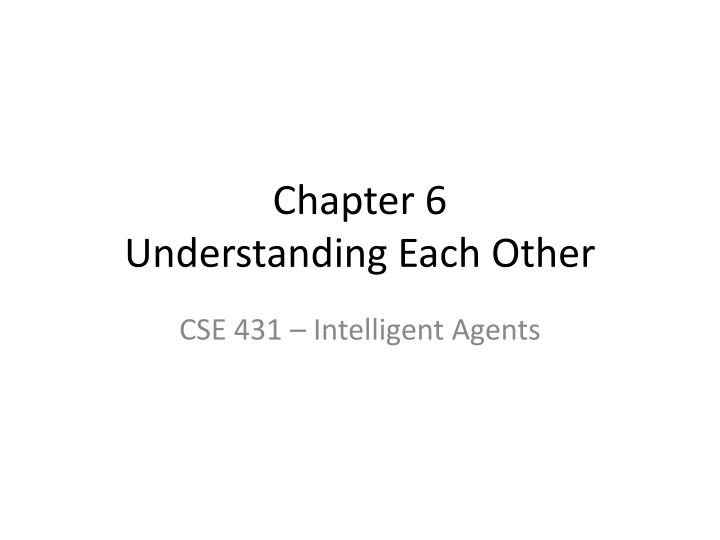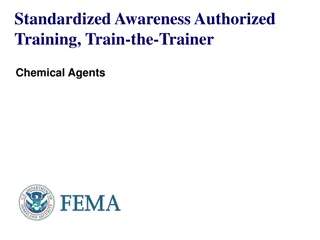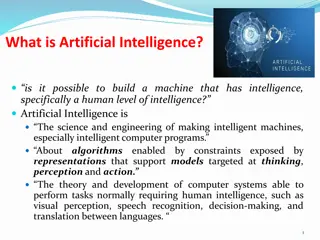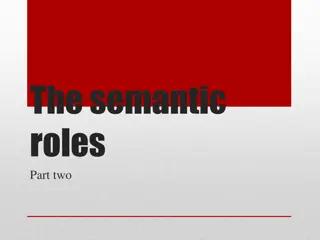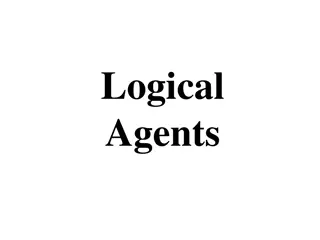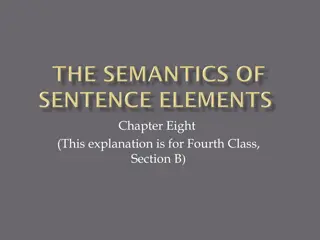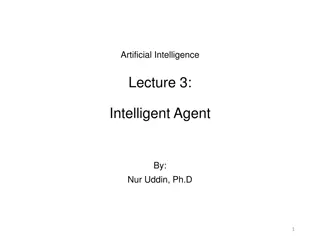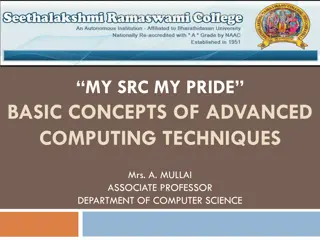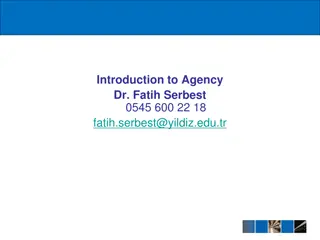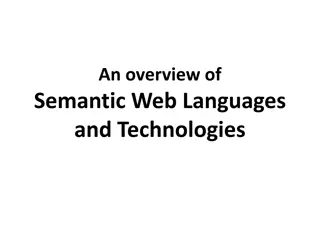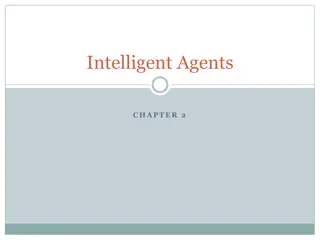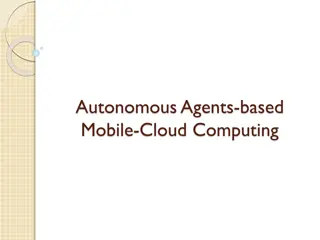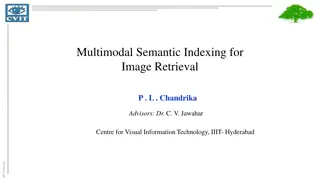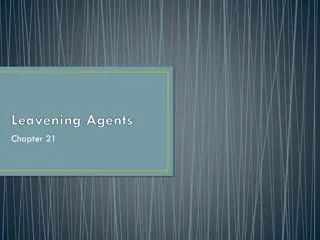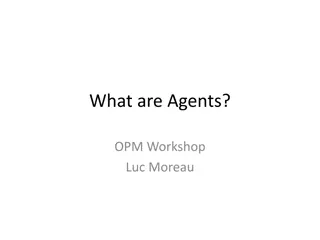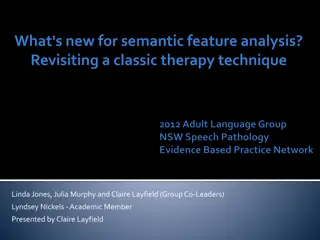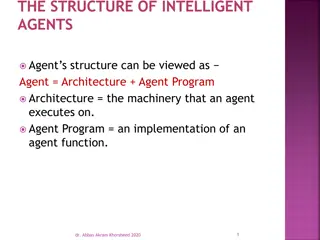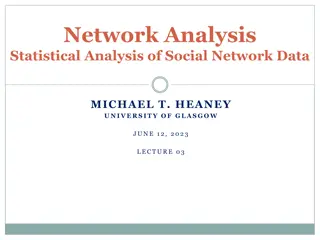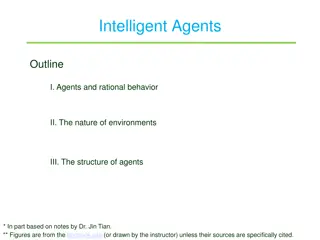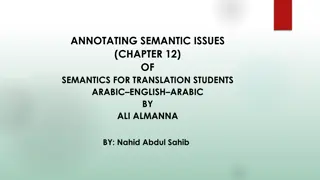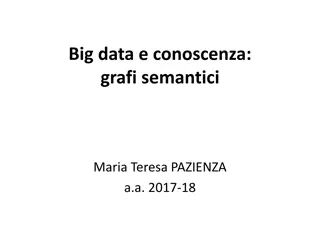Understanding Intelligent Agents and Semantic Networks in Computing
Explore the world of intelligent agents, XML, RDF, OWL, ontologies, and class constructors in computing. Delve into how these technologies enable machines to understand, communicate, and process data efficiently.
Download Presentation

Please find below an Image/Link to download the presentation.
The content on the website is provided AS IS for your information and personal use only. It may not be sold, licensed, or shared on other websites without obtaining consent from the author.If you encounter any issues during the download, it is possible that the publisher has removed the file from their server.
You are allowed to download the files provided on this website for personal or commercial use, subject to the condition that they are used lawfully. All files are the property of their respective owners.
The content on the website is provided AS IS for your information and personal use only. It may not be sold, licensed, or shared on other websites without obtaining consent from the author.
E N D
Presentation Transcript
Chapter 6 Understanding Each Other CSE 431 Intelligent Agents
XML Example <?xml version="1.0" ?> <cd sernum="99999"> <!-- IMHO, a truly great CD --> <title>Yankee Hotel Foxtrot</title> <artist>Wilco</artist> <cover photo="/covers/yht.gif" /> <track no="4">War on War</track> </cd>
RDF and OWL World Wide Web Consortium (W3C) Recommendations RDF(S) (1999, revised 2004) labeled directed graphs essentially semantic networks with URIs XML serialization syntax OWL (2004) extends RDF with more semantic primitives based on description logics (DLs) has a model theoretic semantics rdfs:Class rdf:Property <owl:Class rdf:ID= Band > <rdfs:subClassOf> <owl:Restriction> <owl:onProperty rdf:resource= #hasMember /> <owl:allValuesFrom rdf:resource= #Musician /> </owl:Restriction> </rdfs:subClassOf> </owl:Class> rdf:type rdf:type g:Person rdf:type rdfs:domain rdfs:subclassOf u:Chair g:name A Band is a subset of the groups which only have Musicians as members rdf:type g:name John Smith 3 of 30
Ontology Header <!DOCTYPE rdf:RDF [ <!ENTITY owl "http://www.w3.org/2002/07/owl#">]> <rdf:RDF xmlns:owl ="http://www.w3.org/2002/07/owl#" xmlns:rdf ="http://www.w3.org/1999/02/22-rdf-syntax-ns#" xmlns:rdfs="http://www.w3.org/2000/01/rdf-schema#"> <owl:Ontology rdf:about=""> <rdfs:label>My Ontology</rdfs:label> <rdfs:comment>An example ontology</rdfs:comment> <owl:imports rdf:resource= http://www.ont.org/generic /> </owl:Ontology> ... </rdf:RDF>
OWL Class Constructors example taken from Ian Horrocks
Defining Simple Classes owl:Class subset of rdfs:Class, excludes metaclasses rdfs:subClassOf specify formal taxonomies owl:Thing set of all individuals owl:Nothing empty set of individuals
Defining Properties two kinds object properties relation between two objects datatype properties relations between an object and a datatype value constructors rdfs:domain rdfs:range rdfs:subPropertyOf
OWL Axioms example taken from Ian Horrocks
Equality/Inequality Two URIs refer to the same individual. <p:Person rdf:about= http://www.cse.lehigh.edu/~heflin/ > <owl:sameAs rdf:resource= http://www.cs.umd.edu/~heflin/ /> </p:Person> Two URIs refer to distinct individuals <p:Person rdf:about= http://www.cse.lehigh.edu/~heflin/ > <owl:differentFrom rdf:resource= mailto:heflin@cse.lehigh.edu /> </p:Person>
Sets of Distinct Individuals <owl:AllDifferent> <owl:distinctMembers rdf:parseType= Collection > <p:Person rdf:about= #Bob /> <p:Person rdf:about= #Sue /> <p:Person rdf:about= #Mary /> </owl:distinctMembers> </owl:AllDifferent> The URIs #Bob, #Sue and #Mary all refer to distinct individuals.
All Values From <owl:Class rdf:ID= Band > <rdfs:subClassOf> <owl:Restriction> <owl:onProperty rdf:resource= #hasMember /> <owl:allValuesFrom rdf:resource= #Musician /> </owl:Restriction> </rdfs:subClassOf> </owl:Class> A Band is a subclass of the set of entities which only have members that are Musicians
Some Values From <owl:Class rdf:ID= Band > <rdfs:subClassOf> <owl:Restriction> <owl:onProperty rdf:resource= #hasMember /> <owl:someValuesFrom rdf:resource= #Singer /> </owl:Restriction> </rdfs:subClassOf> </owl:Class> Every Band has at least one member who is a Singer
Has Value <owl:Class rdf:ID= Guitarist > <rdfs:subClassOf> <owl:Restriction> <owl:onProperty rdf:resource= #playsInstrument /> <owl:hasValue rdf:resource= #Guitar /> </owl:Restriction> </rdfs:subClassOf> </owl:Class> A Guitarist is a subclass of the set of entities which play at least one instrument that is a Guitar.
Minimum Cardinality <owl:Class rdf:ID= Parent > <owl:equivalentClass> <owl:Restriction> <owl:onProperty rdf:resource="#hasChild" /> <owl:minCardinality rdf:datatype= "&xsd;nonNegativeInteger">1</owl:minCardinality> </owl:Restriction> </owl:equivalentClass> </owl:Class> Parent is exactly the set of entities which have at least one child.
Intersection and Union <owl:Class rdf:ID= Father > <owl:intersectionOf rdf:parseType= Collection > <owl:Class rdf:about= #Parent /> <owl:Class rdf:about= #Male /> </owl:intersectionOf> </owl:Class> A Father is exactly a Parent who is also Male. <owl:Class rdf:ID= Person > <owl:unionOf rdf:parseType= Collection > <owl:Class rdf:about= #Woman /> <owl:Class rdf:about= #Man /> </owl:unionOf> </owl:Class> Every Person is Male or Female.
Complement <owl:Class rdf:ID= Man > <owl:intersectionOf rdf:parseType= Collection > <owl:Class rdf:about= #Person /> <owl:Class> <owl:complementOf rdf:resource= #Woman /> </owl:Class> </owl:intersectionOf> </owl:Class> Man is every Person who is not a Woman.
Disjoint Classes <owl:Class rdf:ID= Male > <owl:disjointWith rdf:resource= #Female > </owl:Class> How is this different from owl:complementOf? owl:disjointWith does not allow you to conclude that if someone is not Male, then they must be Female This is a weaker statement than owl:complementOf!
Enumerated Classes <owl:Class rdf:ID= PrimaryColor > <owl:oneOf rdf:parseType= Collection > <owl:Thing rdf:about= #Red /> <owl:Thing rdf:about= #Blue /> <owl:Thing rdf:about= #Yellow /> </owl:oneOf> </owl:Class> PrimaryColor has exactly three instances: Red, Blue and Yellow.
Reasoning with OWL Consistency checking Does the ontology contradict itself? Subsumption C D: is D more general than C? Concept satisfiability Is it possible for a concept to have instances? Classification What is the proper place of a concept in a taxonomy?
The Semantic Web Definition The Semantic Web is not a separate Web but an extension of the current one, in which information is given well-defined meaning, better enabling computers and people to work in cooperation. (Berners-Lee et al., Scientific American, May 2001) Ontology a key component of the Semantic Web ontologies define the semantics of the terms used in semi-structured web pages identify context, provide shared definitions has a formal syntax and unambiguous semantics usually includes a taxonomy, but typically much more inference algorithms can compute what logically follows
Linked Data > 149 billion triples of data in over 2800 data sets
Level of Adoption? Open source Semantic Web tools from IBM, Hewlett-Packard, Nokia, etc. Commercial software vendors Oracle 11g RDBMS supports RDF and much of OWL Adobe s products use RDF to provide metadata for documents, photos Semantic Web specific companies: TopQuadrant, Aduna Software, etc. >400 million Semantic Web documents (as of October 2011) Yahoo SearchMonkey uses RDF to present richer search results Google indexes RDFa (a means for embedding RDF in web pages) Semantic Web enabled sites Data.gov: much of U.S. government s open data is available in RDF Newsweek: annotates articles with RDFa Library of Congress: modernize the bibliographic environment BBC Music: exports RDF playlists, RDF for all artists DBPedia: a Semantic Web version of Wikipedia BestBuy publishes product and store information in RDF
Ontology Engineering determine domain and scope consider reusing existing ontologies enumerate important terms define the classes and the class hierarchy define the properties define the property restrictions (facets) create instances check for anomalies
